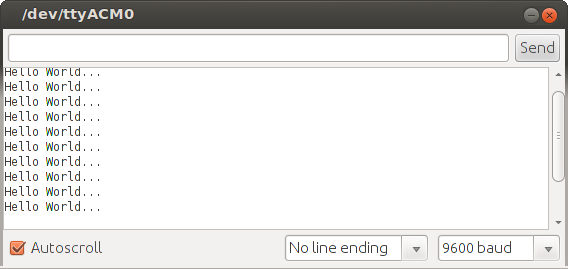

If you have an Arduino (or radio) connected you should receive data in the terminal. Choose the correct Com-port and click connect in the top left corner in the program.
#SERIAL TERMINAL PROGRAM ARDUINO SERIAL#
For more circuit examples, see the Fritzing project page CodeĬreate a variable to hold the baud rate at which the processors will communicate and a variable to determine if entering command mode or not. Terminal by Bray is a freeware program that can read and store data coming from the serial ports. The command for clearing a terminal screen is ESC2J.

I suggest using an actual terminal emulator, like Putty. '~' followed by '~' -> Sends the bridge's shutdown command to obtain the console. The Arduino serial monitor isnt a regular terminal so its not possible to clear the screen using standard terminal commands. '~' followed by '3' -> Set the UART speed to 500000 baud The functions like Serial.begin(),Serial.print() and Serial.

#SERIAL TERMINAL PROGRAM ARDUINO HOW TO#
'~' followed by '2' -> Set the UART speed to 250000 baud The arduino IDE has so many built-in functions which help in the serial communication process and the details of a few functions for initializing the hardware and sending the data to the serial port are discussed in the previous project how to send data from the serial port of arduino. '~' followed by '1' -> Set the UART speed to 115200 baud '~' followed by '0' -> Set the UART speed to 57600 baud You can also use the serial monitor as a basic command line interface for Linux using this sketch.įrom the serial monitor the following commands can be issued:

Upload this to a Yún device via USB (not over WiFi) then open the serial monitor at 115200bps to see the boot process of the Linux processor. Serial.write() - Writes binary data to the serial port.This example allows you to use the Yún's 32U4 processor or the microcontroller of the board attached to the shield as a serial terminal for the Linux processor. Serial.read() - Reads the incoming Serial data from an object. This command takes the same forms as Serial.print. Serial.println() - Prints data to the serial port as human-readable ASCII text followed by a carriage return character (ASCII 13, or '\r') and a newline character (ASCII 10, or '\n'). Floats are similarly printed as ASCII digits, defaulting to two decimal places. Numbers are printed using an ASCII character for each digit. Serial.print() - Prints data to the serial port as human-readable ASCII text. The default is 8 data bits, no parity, one stop bit. You can, however, specify other rates - for example, to communicate over pins 0 and 1 with a component that requires a particular baud rate.Īn optional second argument configures the data, parity, and stop bits. Programming Arduino for serial Communication: Arduino has built in library to use Rs232 protocol, so we don’t need to write the whole protocol and take care about the credibility of the data because RS232 library will take care of it. For communicating with Serial Monitor, make sure to use one of the baud rates listed in the menu at the bottom right corner of its screen. Serial.begin() -Sets the data rate in bits per second (baud) for serial data transmission. This is data that’s already arrived and stored in the serial receive buffer (which holds 64 bytes). Serial.available() - Get the number of bytes (characters) available for reading from the serial port. Returns true if the specified serial port is available. For all other boards, and the non-USB CDC ports, this will always return true. On the boards with native USB, if (Serial) (or if(SerialUSB) on the Due) indicates whether or not the USB CDC serial connection is open. This is pretty simple but it can be a bit confusing at first especially if you’re new to programing and the Arduino. If(Serial) - indicates if the specified Serial port is ready. In this lesson, I will be going through on how to setup the Arduino serial monitor so you can debug and interact with a program running on the Arduino.


 0 kommentar(er)
0 kommentar(er)
